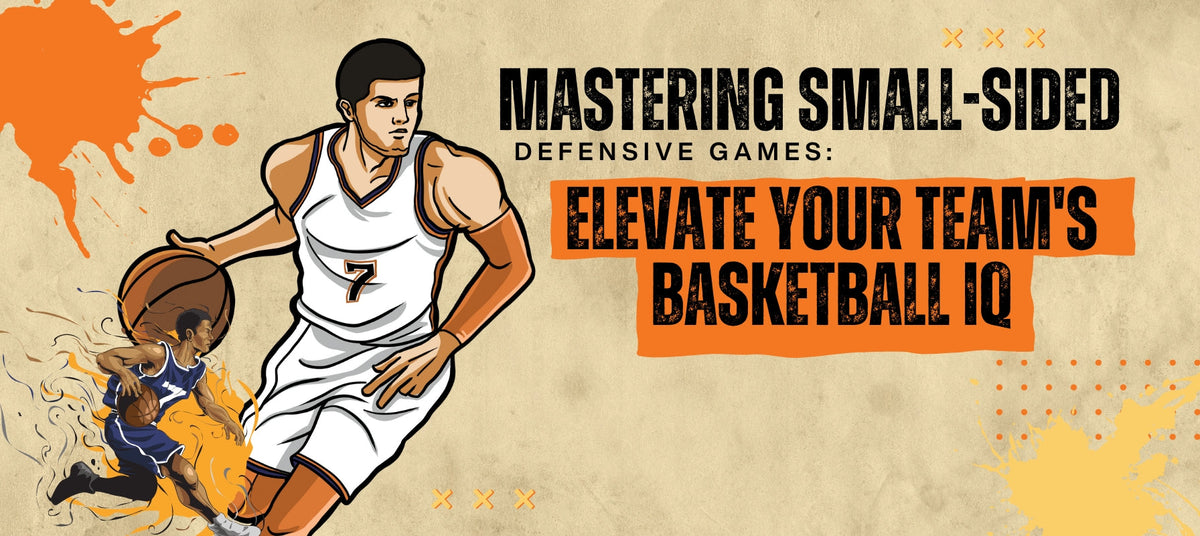
Mastering Small-Sided Defensive Games: Elevate Your Team's Basketball IQ
|
|
Time to read 5 min
|
|
Time to read 5 min
Coaches constantly search for ways to make practice engaging while also improving their team's skills and basketball IQ. That's where small-sided defensive games in basketball come into play. Unlike traditional drills that can feel repetitive and disconnected from the game, these smaller-scale scrimmages offer a dynamic and effective approach to teaching vital defensive principles. This happens in a fun, competitive environment, leading to better engagement and faster skill development. The end result is a stronger defensive team on the court.
Small-sided defensive games basketball, at their core, are scrimmages involving fewer players than a standard 5-on-5 game. These games typically involve 1-on-1, 2-on-2, or 3-on-3 matchups, creating more repetitions for players. They can be adjusted based on the coach's goals and the number of players available. By creating a more concentrated playing environment, coaches can zero in on specific skills, allowing players to work on defensive techniques. This occurs in a game-like situation that fosters quick decision-making and reaction.in
These small-sided defensive games basketball go beyond rote drills. They transform the court into a live classroom, which helps with player development. This approach taps into players' natural competitive spirit, making learning fun. It also promotes active participation over passive observation.
When players are engaged, they naturally absorb information better. It's this very engagement that leads to greater comprehension and retention of vital defensive principles. Players buy into the drills more, especially when they're having fun.
One of the greatest strengths of small-sided games is their ability to break down complex defensive concepts into digestible pieces. It becomes easier to focus on a specific element within a smaller, controlled setting. This could be anything from closeouts to rotations, or on-ball defense.
For example, a coach can create a 2-on-2 game where the offensive players are limited to a certain number of dribbles. This constraint compels the defensive players to hone their footwork. It also helps them maintain a low stance, and effectively 'wall up' to prevent drives to the basket.
While drills have their place, small-sided games offer a realistic simulation of in-game scenarios. This 'learn-by-doing' method fast-tracks a player's development. This is done by providing valuable experience in making split-second decisions and communicating effectively with teammates.
The constant action demands awareness, adaptability, and sharp on-the-fly thinking. These are all things that directly translate to game-time situations and lead to more success for players.
Small-sided games in basketball are as diverse as the coaches who use them. They are easily modified to target a specific defensive principle or skill. Here are a few examples:
This game emphasizes denying the pass and staying in front of the offensive player. It helps players understand proper defensive positioning without fouling.
This variation focuses on closing out to the nearest offensive player while maintaining defensive balance. It also emphasizes proper help-side positioning.
This game encourages strong on-ball defense, and disciplined positioning, and reinforces the importance of each player winning their individual matchups. There is an emphasis on staying in front of your man and not relying on help defense.
This game utilizes three teams of four to work on defensive concepts. It promotes communication, transition defense, and a competitive spirit among teammates.
This game integrates into regular scrimmages (like 5-on-5). A 'knockout' could be anything the coach chooses (e.g., three consecutive stops, a charge taken, etc). It introduces a fun, competitive layer, encourages hustle, and keeps players on their toes.
Successfully using small sided games to teach defense isn't simply a matter of tossing a ball onto the court. It requires thought and intentional planning from the coaching staff.
Begin each game by communicating the purpose and desired learning outcome to your players. Emphasize the 'why' behind each activity. This ensures athletes grasp the relevance of each game to their development.
Don't try to tackle too much too quickly when teaching new defensive concepts. Start with simple concepts and gradually introduce complexity. Begin by focusing on basic fundamentals—positioning, footwork, and communication.
Once those are mastered, then you can introduce more advanced tactics. This could include things like help rotations or trapping.
Constraints aren't punishments, rather they are tools that amplify learning. Coaches can restrict certain actions to highlight and target specific aspects. This allows for good concentration on specific skills.
An example would be limiting dribbling, requiring a set number of passes before a shot, or restricting movement to designated areas of the court. This shifts the players' focus toward finding creative solutions within limitations. In turn, it pushes them to refine specific skill sets.
Keep feedback short, focused, and immediately actionable, offering insights and adjustments during natural stoppages in play. This helps maintain the game's flow and avoids overwhelming players with too much information.
The true brilliance of incorporating small-sided defensive games basketball lies in their ripple effect. These games extend beyond technical skills and delve into the core aspects of a successful basketball team. This includes things such as communication, teamwork, and basketball IQ.
By participating in these small-sided games, players aren’t just developing their defensive abilities. They are also developing their overall understanding and awareness of the game itself. This approach goes a long way toward building strong team chemistry.
Small-sided defensive games basketball have evolved from a novel training method to a staple for coaches. Especially for those looking to build robust, agile, and adaptable defenses. The power lies in the simple yet potent combination of competition, focused skill development, and most importantly, fun.
By cultivating an engaging learning environment on the court, these games not only empower players with critical defensive tools but also unlock a heightened understanding and passion for the game that transcends beyond the practice court. It also gives players a chance to improve.
Defensive Games.Defensive Games.Defensive Games.Defensive Games.Defensive Games.Defensive Games.Defensive Games.Defensive Games.Defensive Games.Defensive Games.Defensive Games.Defensive Games.Defensive Games.Defensive Games.Defensive Games.Defensive Games.Defensive Games.Defensive Games.Defensive Games.Defensive Games.Defensive Games.Defensive Games.Defensive Games.
